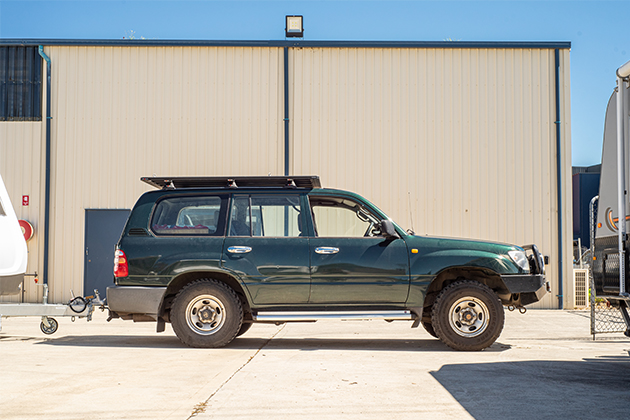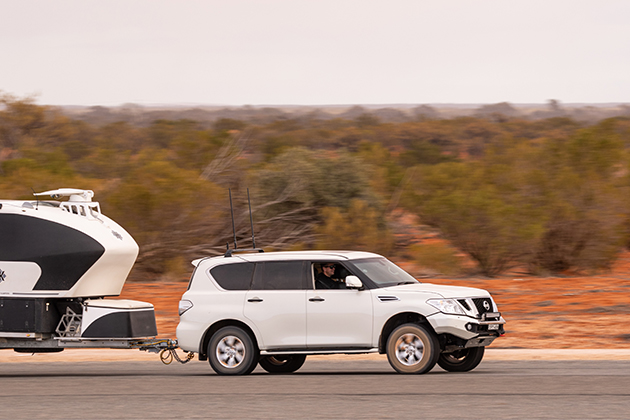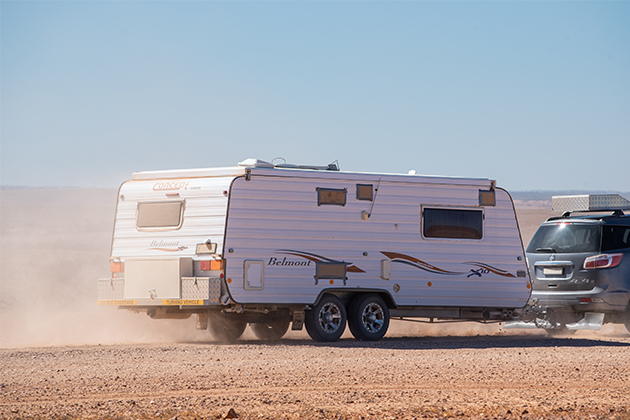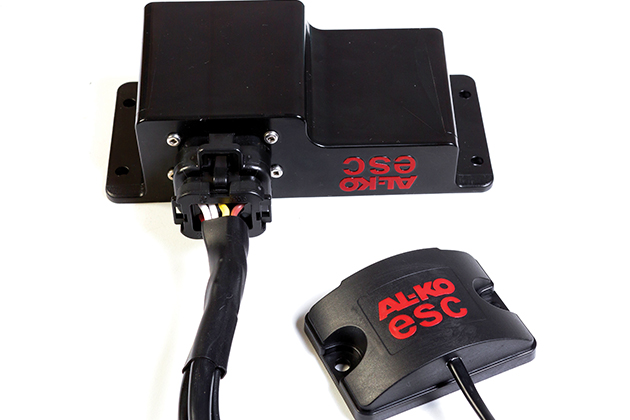By: Brendan Batty
If we are to believe the hype surrounding modern vehicle marketing, towing your dream caravan or trailer is as simple as buying the latest SUV and hooking up. But, there’s more to consider than where you’ll be lighting your first campfire.
Absolutely key to getting there safely is how well the weight of your new caravan and all your gear is distributed across the car.
Get it right, and the trips will be unforgettable. Get it wrong, and they’ll still be unforgettable, but not for the same reasons.
What is weight distribution?
Weight distribution is simply how the total mass of a vehicle (including passengers, luggage, accessories and appendages like trailers) is spread across its contact points with the road – the tyres and axles. The ideal is to spread it all evenly so that no one point is significantly more loaded than another.
From the factory, your car or four-wheel drive will have an ideal balance, which might be that 45 per cent of the vehicle’s mass is over the front wheels and the other 55 per cent is over the rear.
Adding weight anywhere on the vehicle changes its dynamics. To a certain extent, the engineers who dreamt up your car accounted for it – a ute with a few hundred kilos of tools in the tray usually rides better than one with gym bags and kids’ scooters. But there are limits, and there are scenarios that exacerbate poor weight balance more than others. Adding weight behind the rear axle is one of those scenarios, and that’s precisely what we do when we hitch up a trailer, especially heavy ones like caravans, boats and camper trailers.
RELATED:
Calculating your car and caravan towing limits »
By adding weight behind the rear axle, we’re creating a lever where the pivot point is the back wheels. As more weight pushes down on the back, it lifts the front, like a seesaw. But the spread of weight isn’t even. If you weigh the rear axle as you hitch your caravan, you might notice that the weight increase is more than the weight of the hitch itself.

In one example demonstrated by the NRMA, adding 250kg of ball weight to an Isuzu MU-X increased the rear axle load by 380kg. That’s more than half its allowed rear axle load (roughly 600kg), just because of 250kg of extra weight. That additional 130kg didn’t appear out of nowhere, either. It had been transferred back from the front axle, which then had 130kg less weight over it.
Interestingly, weight distribution isn’t affected by how firm or soft the suspension is. Just fitting ‘stiffer’ suspension to fix rear-end sag won’t solve the problem. The caravanning magazine ROAM measured the effect tow ball load had on axle weights with normal and blocked out suspension. The front end still got lighter even if the rear end didn’t sag at all.
How do you fix poor weight distribution in a caravan?
There are two sure-fire ways to fix an imbalance in your car and caravan, and in combination, they work a treat. The best way is to ensure your combination is packed so that the car’s rear end isn’t overloaded. That might be as drastic as getting a new car (bigger, with more load capacity) or new caravan (smaller and lighter). Of the two, the latter is probably the smarter choice.
For those on a budget, you might just have to pack less and avoid packing or fitting heavy accessories to the front (or back) of the caravan. We’re looking at you, large toolboxes and motorcycle racks.
If you’ve packed the trailer or caravan and it’s still heavy over the tow ball, using a weight-distribution hitch is the only way to shift weight from your car’s rear axle to the front wheels. These work by levering the car in opposition to the caravan, forcing the front end down. At the same time, this removes weight from the rear axle, so it’s possible to undo any potential overload.
The easiest way to know if you’ve got the right amount of weight over the front axle is to measure the front wheel arch height. If it’s the same with and without the caravan, or slightly lower, you’ve got the car well balanced. There’s more weight on the car, so the rear will sink a little, also. If the front wheel arch is significantly higher than it was before, your balance is not right, and you need to change something.
RELATED:
How to safely pack your car, caravan or trailer for a road trip »

Why is weight distribution so important?
When the caravan puts so much weight on the rear that it levers the front end up, its ability to brake effectively is seriously hindered. With less weight on the front wheels, the forward bias of a braking system is compromised.
In the same example demonstrated by the NRMA, it was found that the MU-X and 2.5-tonne caravan could stop three metres sooner when fitted with a weight-distribution hitch – 25m versus 28m.
Three metres might not sound like much, but after 25m of hard braking, the car without the weight distribution hitch was still travelling at 30km/h. That’s fast enough to set off the airbags. Or kill a pedestrian.
Proper weight distribution will also help avoid caravan sway, about which there’s more detail below. With the correct amount of weight over the front of the tow vehicle, the caravan will have a harder time ‘pushing’ the car around, and the car will have better steering feel (it won’t be light and airy).
It will also improve the ride and handling of the car. The suspension at both ends will have more range and won’t feel too wallowy in the front and too firm or bumpy in the back. In the long run, tyre wear will also benefit. All of which makes for a much more enjoyable holiday. And that’s the only reason to go caravanning, right?
Caravan sway
Caravan sway, or snaking, is one of the most unsettling experiences you can ever have on the road, and it can, and does, lead to disaster. Several factors cause it, but so we are clear, no amount of sway is acceptable, especially the inherent type that just develops at a certain speed, no matter the conditions. If you are experiencing caravan sway every time you tow, no matter how minor, something is wrong.
Sway is when the caravan is snaking or swerving behind the car. Because the caravan is following a swerving path, while the vehicle is mostly still going straight, it’s actually going faster than the car towing it. Once we get our heads around that, understanding and dealing with sway is relatively easy.
There are many reasons a trailer could be ‘going faster’ than the car towing it. As a car brakes down a hill, the trailer’s inertia will want it to keep moving forwards at the speed it was going. A gust of wind, hitting the trailer like the sail of a yacht, could add energy to the trailer, knocking it off course. Bumps or undulations in the road or even a sudden and sharp steering action to avoid a pothole or some wildlife, could force the suspension to work harder on one side, disrupting the trailer’s balance.
Sway is also more likely to develop when the caravan carries most of its mass at its ends. Sometimes this is poor design, like when trailer manufacturers fit heavy accessories right back (like wheel carriers, toolboxes or water tanks) to lighten the hitch load. Other times it’s because the most convenient storage spaces are at the ends of the caravan – under the bed and on the drawbar, and we Aussies love packing as much as we can.

So, there are a few things we can do. The first is to steer clear of caravans or trailers that have been ‘balanced’ by the manufacturer with heavy accessories on the rear. That’s usually a mark of poor design. Caravans are best when they carry most of their mass down low and as close as possible to the axles.
When packing our trailers or caravans, aim to pack the heaviest things over the axles (working within the constraints of our caravan’s layout, of course). Even consider spreading some of the load onto the tow car. Bikes might be better placed on the roof of the car, rather than the back of the caravan, for instance. Only pack the lightest things up high or at the back.
The best scenario is to have the caravan balanced so there’s about 10 per cent of its total weight on the tow ball when it’s under tow, without resorting to excessive mass on the rear. A little over or under is okay. Caravans handle best when they sit level. Nose up or down shifts weight to just one of the axles and reduces the contact it has with the road. Take some air out of the tow vehicle’s front wheels, too, to increase their connection with the road.
Sway is best managed by slowing down the caravan. Although there’s a lot of commentary saying you should accelerate out of sway, there’s a whole host of reasons why that’s a bad idea. More than likely, you’ll just increase the chance of a crash, and you’ll be going faster when it happens.
There is a range of great aftermarket products to deal with caravan sway, but most people probably have the means of slowing down their caravan at their fingertips already – the override function on your electronic brake control. Pressing it will apply the caravan’s brakes only, very effectively slowing it down and bringing it into line with the car. It’s a great skill to know exactly where that button is and to practice pressing it without looking at it, so you know you can do it in an emergency.

That’s essentially how all the sway control systems work. While they vary in sophistication, all of them apply the caravan’s brakes, when they detect sway, to slow it down to the same speed as the car. Some, like ESC from AL-KO, apply all the brakes at once. Others, like Dexter Sway Control, apply individual brakes to slow wheels one side at a time.
Need some more caravan advice before setting off?
We're running free caravan safety training sessions in Perth and regional WA to help you travel safely.
Last updated: February 2021
